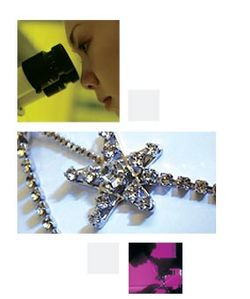Nickel is now the most frequent cause of contact allergy in Europe. Skin absorption of nickel ions, released from nickel containing materials, can lead to sensitisation. The degree of sensitivity to nickel varies between individuals. This widespread health problem has forced the introduction of measures to reduce the development of allergic contact dermatitis to nickel.
Why is nickel used by manufacturers?
Nickel has been used for many years because of the physical properties it bestows on an article of jewellery. For example:
When a rough casting is made it can be overplated with nickel and made very smooth. (This process is known as 'levelling').This smooth surface when overplated with silver or gold is extremely bright. When nickel is plated as a continuous layer it acts as a barrier to the migration of copper to the surface. Copper oxidises, turns green and roughens the surface. A product's strength and durability are both increased by the addition of nickel. Precious metal alloys are mixtures of several metals chosen for colour, strength or hardness. Nickel added to gold may bleach it thus producing a white gold alloy.
Nickel has been used for many years and the industrial expertise is well developed. It is also inexpensive when compared to the available alternatives such as palladium.
Consumer Protection
Following EU Directives. BS EN 1811:1998 was developed and reviewed in several occasions. The latest version, BS EN 1811:2011 +A1 2015 has been in effect since the 31st August 2015.This establishes the compliance levels for an article as follows:
The compliance levels for an article are:
- Migration limit of 0.5µg/cm2/week for articles intended to come into direct and prolonged contact with skin.
- An article is non-compliant when the nickel release is greater than or equal to 0.88µg/cm2/week
- An article shall be accepted and permitted to be placed on the market if the measured value is less than 0.88µg/cm2/week
- Migration limit of 0.2µg/cm2/week for all post piercing assemblies inserted into pierced ears and other pierced parts of the human body
- An article is non-compliant when the nickel release is greater than or equal to 0.35µg/cm2/week
- An article shall be accepted and permitted to be placed on the market if the measured value is less than 0.35µg/cm2/week
Our Service
Sheffield Analytical Services undertakes chemical analyses and testing of items for nickel release under EC Nickel Directive 1907/2006 REACH Annex XVII, Item 27.
Items may range from fashion jewellery and accessories to belt buckles. The primary reason for importers, manufacturers and multiple retailers to use this service is confirmation of due diligence. We number many national retailers amongst our clients and offer:
- UKAS accredited
- Due diligence defence
- Confidential and friendly service
- Rapid and accurate results
Nickel release tests:
The testing procedure involves first identifying parts of an article that may contact broken or unbroken skin, assessing for coatings and then applying the appropriate tests.
|
Test |
Description |
|
Based to BSEN 1811:2011 + A1:2015 and BSEN 12472 |
Prior to carry the test method in accordance with BSEN 1811, articles are subjected to a procedure of corrosion and wear which simulates a period of two years' normal use. Then, each article is divided into components to identify component part release. |
|
QC |
Tested as per BS EN 1811 but item is not split into its components – indicative of compliance only |
Nickel content:
- Reporting total nickel content of each component contained in an article using an in-house developed dissolution method
Please get in touch for further details. A Certificate of Conformity Scheme is available that includes Due Diligence Defence, purposive sampling and stock audits.
Click here to download the Analytical Services request form.
